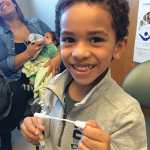Leslie Kelly-Hall, senior vice president of policy at Healthwise, a nonprofit provider of health information and decision support tools, emphasized during the session the importance of collaboration between patients and their healthcare providers in medical decision making. Not involving patients, she said, leads to over- or undertreatment, misunderstandings and “missed opportunities for relationship.” Patients want shared decision making and choices, “including doing nothing,” she said.
Dr. Selby agreed. Patients and other stakeholders should be involved in topic selection and research prioritization, proposal review, design and conduct of research, dissemination and implementation of results, he said. “Patients bring a lived experience of a condition, disease or suboptimal care,” he said.
Moving Beyond the Old-School Approach
Karon Cook, PhD, at the Feinberg School of Medicine at Northwestern University in Evanston, Ill., compared the “old-school approach” of research with methods now being used in patient-reported outcomes research. The NIH-sponsored Patient Reported Outcomes Measurement Information System (PROMIS) is a “great prototype” that identifies outcomes that cut across a range of diseases, she said. More than $110 million was spent to develop the program, and it “has radically changed how patient-reported outcomes are measured,” she added.
PROMIS uses modern measurement theory to assess patient-reported health status and reliably measures those outcomes for both clinical research and practice. Its computer software, called Computer Adaptive Testing (CAT), has combined the advancements in measurement theory with technology so that a patient’s responses to previous questions lead to automatic selection of the next questions the patient is asked. The patient is therefore queried on a minimal number of questions, but there is no loss in measurement precision. In one example, use of CAT required only 16% to 22% of time to complete compared with the time required to complete a “legacy measurement,” Dr. Cook said.
Collaborative Networks of Patient Data
In his presentation about PCOR and patients as partners in research, Jeffrey R. Curtis, MD, MPH, MS, at University of Alabama at Birmingham, noted that $500 million to $800 million is required to develop a drug from bench to bedside, with most drug trials not finishing on time and only about 6% of physicians participating in the trials. “Not all questions can be answered or should be answered by traditional clinical trials, which are typically expensive and inefficient,” he said.
According to Dr. Curtis, using a network like PCORnet or registry data can provide substantial cost savings for data collection, enhanced outcome assessment, more drug exposure information and information about hospitalizations, emergency department visits and outpatient care.


